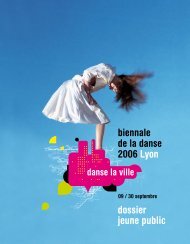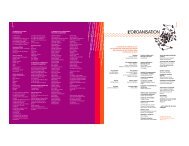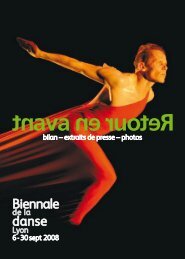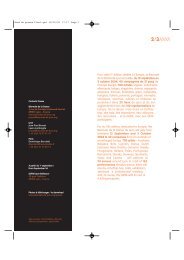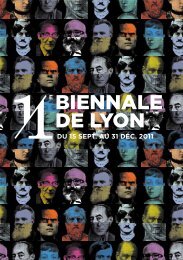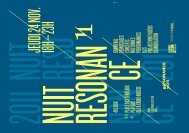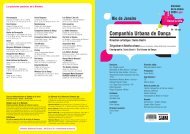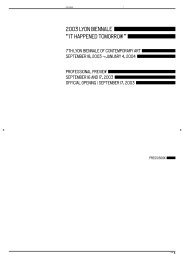Retour en Avant / Past Forward Biennale de la Danse Lyon - France
Retour en Avant / Past Forward Biennale de la Danse Lyon - France
Retour en Avant / Past Forward Biennale de la Danse Lyon - France
- No tags were found...
Create successful ePaper yourself
Turn your PDF publications into a flip-book with our unique Google optimized e-Paper software.
lem<strong>en</strong>t au cinéma (Tati, Keaton, Chaplin).En 1988, Vera Bicalho le nomme chorégraphe-résid<strong>en</strong>t<strong>de</strong> Quasar Dance Co. Il a crééà ce jour 18 pièces pour <strong>la</strong> compagnie. Sarecherche basée sur <strong>la</strong> complexité du corpset <strong>de</strong> l’esprit donne à <strong>la</strong> compagnie uneréelle id<strong>en</strong>tité alliant tonicité et fluidité,humour et simplicité. En 1994, avec <strong>la</strong> créationVersus, il acquiert <strong>la</strong> réputation d’un<strong>de</strong>s créateurs les plus innovants <strong>de</strong> <strong>la</strong> danseau Brésil. Il s’intéresse <strong>de</strong>puis quelquesannées aux techniques du multimédia pourune meilleure interactivité <strong>en</strong>tre le mon<strong>de</strong>réel et l’imaginaire créé sur scène, <strong>en</strong>tre lepublic et les danseurs. La compagnie a étéprés<strong>en</strong>tée <strong>en</strong> <strong>France</strong> lors <strong>de</strong> <strong>la</strong> Bi<strong>en</strong>nale <strong>de</strong> <strong>la</strong><strong>Danse</strong> <strong>de</strong> <strong>la</strong> <strong>Danse</strong> <strong>en</strong> 2002.Palpable / création 2007Le chorégraphe Andonis Foniadakis évoque« quelque chose que l’on peut s<strong>en</strong>tir ettoucher, et qui éveille le côté s<strong>en</strong>soriel <strong>de</strong>sdanseurs et du spectateur ». Dans une quêteint<strong>en</strong>se <strong>de</strong> <strong>la</strong> cinétique, celui du mouvem<strong>en</strong>tdu corps, le chorégraphe cherche à produire<strong>de</strong>s mouvem<strong>en</strong>ts doux, d’une gran<strong>de</strong>virtuosité. « Je cherche dans <strong>la</strong> chorégraphieà explorer <strong>la</strong> légèreté <strong>de</strong>s pas et à obt<strong>en</strong>irà partir <strong>de</strong> là un résultat harmonieux etdoux » dit le chorégraphe.Andonis FoniadakisNé <strong>en</strong> Crête <strong>en</strong> 1971, Andonis Foniadakissuit les cours <strong>de</strong> l’École <strong>de</strong> danse nationale<strong>de</strong> Grèce <strong>de</strong> 1998 à 1990, puis l’École Mudraà Lausanne <strong>de</strong> 1990 à 1992. Maurice Béjartl’intègre <strong>en</strong>suite dans sa compagnie où ilparticipe <strong>en</strong> tant qu’interprète à <strong>de</strong> nombreusescréations (King Lear; L’art du Pas <strong>de</strong>Deux; Shéhéraza<strong>de</strong>; Wagner…) et crée <strong>en</strong>même temps ses premières chorégraphies(In Betwe<strong>en</strong>, 1994; Court Métrage, 1996).De 1996 à 2002, il est <strong>en</strong>gagé au Ballet<strong>de</strong> l’Opéra National <strong>de</strong> <strong>Lyon</strong>, puis crée sapropre compagnie ApotosΩma. En 2004, ilprés<strong>en</strong>te Use dans le cadre <strong>de</strong> <strong>la</strong> Bi<strong>en</strong>nale <strong>de</strong><strong>la</strong> <strong>Danse</strong> <strong>de</strong> <strong>Lyon</strong>. Il signe <strong>de</strong>s chorégraphiespour d’autres compagnies dont le Ballet<strong>de</strong> l’Opéra National <strong>de</strong> <strong>Lyon</strong>, pour le JeuneBallet du Conservatoire national Supérieur<strong>de</strong> Musique et <strong>de</strong> <strong>Danse</strong> <strong>de</strong> <strong>Lyon</strong>, pour leBallet du Grand Théâtre <strong>de</strong> G<strong>en</strong>ève, pour leThéâtre National <strong>de</strong> <strong>la</strong> Grèce du Nord…Comm<strong>en</strong>t le passé peut-il <strong>de</strong>ssiner l’av<strong>en</strong>ir ?La graine. La graine est le futur <strong>de</strong> l´imparfait. Lagraine est, sera, et était <strong>la</strong> nourriture. C´est un processusqui s´observe dans toute <strong>la</strong> Nature. L´homme créele projet, l´œuvre se reproduit dans le prés<strong>en</strong>t infini :l´éternité. De même, les mouvem<strong>en</strong>ts culturels. Dansce cas précis, le Tropicalisme : mouvem<strong>en</strong>t musicalculturel d´extrême avant-gar<strong>de</strong> et d´un pouvoir révolutionnaire<strong>de</strong> gran<strong>de</strong> <strong>en</strong>vergure. <strong>Avant</strong>-gar<strong>de</strong> est le motqui définit <strong>la</strong> question <strong>de</strong> ce qui sera dans l´av<strong>en</strong>ir lefil conducteur <strong>de</strong> l´Histoire. La question <strong>de</strong>vi<strong>en</strong>t <strong>en</strong>finontologique. Nous ne saurons jamais tout <strong>de</strong> suite <strong>la</strong>raison et/ou <strong>la</strong> projection <strong>de</strong> nos actes. On défoncepour naître. L´inspiration se projettera plus loin <strong>de</strong>façon paradoxale. Car elle est le futur d´un passétoujours prés<strong>en</strong>t. La vraie création ou <strong>la</strong> vraie raison<strong>de</strong> <strong>la</strong> Création.Anselmo Zol<strong>la</strong>Infos +Tropicália / Première <strong>en</strong> EuropeCia Socieda<strong>de</strong> MasculinaThis all-male Brazilian company was establishedin 2003 and invites the cream of Brazil’s andEurope’s choreographers to candidly portray thefeatures of contemporary man. The companywas foun<strong>de</strong>d by Vera Lafer, a dancer and dance-lover,at Studio 3 in São Paulo, a school foradvanced dance training where Anselmo Zol<strong>la</strong>teaches. In <strong>la</strong>te 2003, Anselmo Zol<strong>la</strong>, now theschool’s artistic director alongsi<strong>de</strong> Ivonice Satie,created a piece of choreography, Socieda<strong>de</strong>Masculina, with some of his male stud<strong>en</strong>ts. Herealised that he could explore a world <strong>la</strong>rgelyneglected by choreographers. He <strong>de</strong>ci<strong>de</strong>d topursue the adv<strong>en</strong>ture with these few dancers,and set up a company of the same name.Though a dancer for eight years, Zol<strong>la</strong> prefers tobe a “dance organiser”, creating new choreographicworks and inviting guest choreographersto work with the company. Despite prejudiceagainst male Brazilian dancers, Socieda<strong>de</strong>Masculina has ma<strong>de</strong> its mark over the past threeyears as an all-male company. Comprising eightdancers, it aims to restore consi<strong>de</strong>ration formale dancing while reaching beyond clichés.The dancers are helping the public to rediscovera whole swathe of choreography characterisedby unshowy heroism, athletic virtuosityand str<strong>en</strong>gth. Anselmo Zol<strong>la</strong> and Ivonice Satiehave ma<strong>de</strong> their voices heard and their workappreciated, as well as attracting establishedchoreographers (H<strong>en</strong>rique Rodovalho, DeborahColker, Paulo Caldas, Jorge Garcia and AndonisFionadakis). The company now has some 10pieces in its repertoire. Investigating the movem<strong>en</strong>tthe body is capable of, but also its privateworld, its secrets and, of course, its weaknesses,Socieda<strong>de</strong> Masculina frankly <strong>de</strong>picts the featuresof contemporary, real-life man.“I wanted to work with a small number ofpeople so that I could get the most from eachindividual and their tal<strong>en</strong>t. They have each haddiffer<strong>en</strong>t training – some are more c<strong>la</strong>ssical,others have worked with contemporary danceand other styles, such as jazz and ev<strong>en</strong> capoeira.For me, the fact that they’re not a uniformgroup is <strong>de</strong>finitely a good thing.”Anselmo Zol<strong>la</strong>Tropicália / 2008 creationThe Brazilian’s tells of Tropicalism, a trem<strong>en</strong>douswi<strong>de</strong>-ranging artistic movem<strong>en</strong>t in dictator-ruled1960s Brazil; 40 years on, the most tal<strong>en</strong>tedchoreographer of his g<strong>en</strong>eration stages thisvolcanic art.H<strong>en</strong>rique RodovalhoBorn in 1964 in Goiânia, Brazil, he first studiedmartial arts and physical education before focusingon the re<strong>la</strong>tionship betwe<strong>en</strong> music and movem<strong>en</strong>t;it was th<strong>en</strong> that he started taking c<strong>la</strong>ssical-danceand jazz c<strong>la</strong>sses. In 1986, he sp<strong>en</strong>ttwo years in Rio <strong>de</strong> Janeiro, where he discoveredthe shows of Merce Cunningham and AntonioNobrega. Choreographer Wim Van<strong>de</strong>keybuswould provi<strong>de</strong> his epiphany. He th<strong>en</strong> trainedwith Rainer and Angel Vianna, acted in stagep<strong>la</strong>ys,danced with the Nos <strong>de</strong> Dança companyand dabbled in advertising. He also took an interestin film (Tati, Keaton, Chaplin). In 1988, VeraBicalho appointed him resid<strong>en</strong>t choreographerof Quasar Dance Co. To date, he has created 18pieces for the company. His investigations, basedon the complexity of body and mind, have giv<strong>en</strong>the company a g<strong>en</strong>uine id<strong>en</strong>tity that bl<strong>en</strong>ds tonicity,fluidity, humour and simplicity. In 1994, hiswork Versus earned him a reputation as one ofBrazil’s most innovative dance creators. In rec<strong>en</strong>tyears he has explored multimedia techniques toheight<strong>en</strong> the interactivity betwe<strong>en</strong> the real worldand the imaginary world he conjures on stagebetwe<strong>en</strong> dancers and audi<strong>en</strong>ce. The companywas introduced to Fr<strong>en</strong>ch audi<strong>en</strong>ces at the 2002<strong>Lyon</strong> Dance Bi<strong>en</strong>nale.Palpable / 2007 creationAndonis Foniadakis’ choregraphy evokes “somethingthat can be felt and touched, and whicharouses the dancers’ and spectators’ s<strong>en</strong>sorysi<strong>de</strong>”. In his int<strong>en</strong>se quest for the kinetics ofbody movem<strong>en</strong>t, the choreographer seeks toproduce g<strong>en</strong>tle movem<strong>en</strong>ts of great virtuosity:“In my choreography, I look to explore the lightnessof steps and transform them into a soft,harmonious result.”Andonis FoniadakisBorn on Crete in 1971, Andonis Foniadakistrained at Greece’s state school of dance from1998-1990, th<strong>en</strong> at École Rudra in Lausannefrom 1990-1992. He th<strong>en</strong> joined MauriceBéjart’s company, and performed in many newworks (including King Lear; L’art du Pas <strong>de</strong> Deux;Shéhéraza<strong>de</strong> and Wagner) while also writinghis first choreographies: In Betwe<strong>en</strong> (1994) andCourt Métrage (1996). From 1996-2002, he wasa member of Ballet <strong>de</strong> l’Opéra National <strong>de</strong> <strong>Lyon</strong>,th<strong>en</strong> set up his own company, ApotosΩma.In 2004, he pres<strong>en</strong>ted Use at the <strong>Lyon</strong> DanceBi<strong>en</strong>nale. He has also created works for othercompanies including Ballet <strong>de</strong> l’Opéra National<strong>de</strong> <strong>Lyon</strong>, the youth ballet company at <strong>Lyon</strong>’s nationalmusic and dance conservatory (CNSMD),Ballet du Grand Théâtre <strong>de</strong> G<strong>en</strong>ève, and NorthernGreece national theatre, among others.How can the past shape the future?Grain is the future of the imperfect. Grain is, will be,and was food. It is a process observed throughoutNature. Man <strong>de</strong>vises a project, and the piece of workis reproduced in the infinite pres<strong>en</strong>t: eternity. The samegoes for cultural movem<strong>en</strong>ts – Tropicalism, in thiscase. An extremely avant-gardist cultural and musicalmovem<strong>en</strong>t and a revolutionary power of far-reachinginflu<strong>en</strong>ce. <strong>Avant</strong>-gar<strong>de</strong> is the word that <strong>de</strong>fines thequestion of what will, in the future, be the thread ofhistory. It ultimately becomes an ontological question.We will never immediately know the reason for ouracts and/or how they are projected. We fight hard tobe born. Paradoxically, inspiration will be projectedfurther on, for inspiration is the future of a past thatis still pres<strong>en</strong>t. That is real creativity, or the real reasonfor the Creation.Anselmo Zol<strong>la</strong>Extra info:Tropicália / European Premiere47






